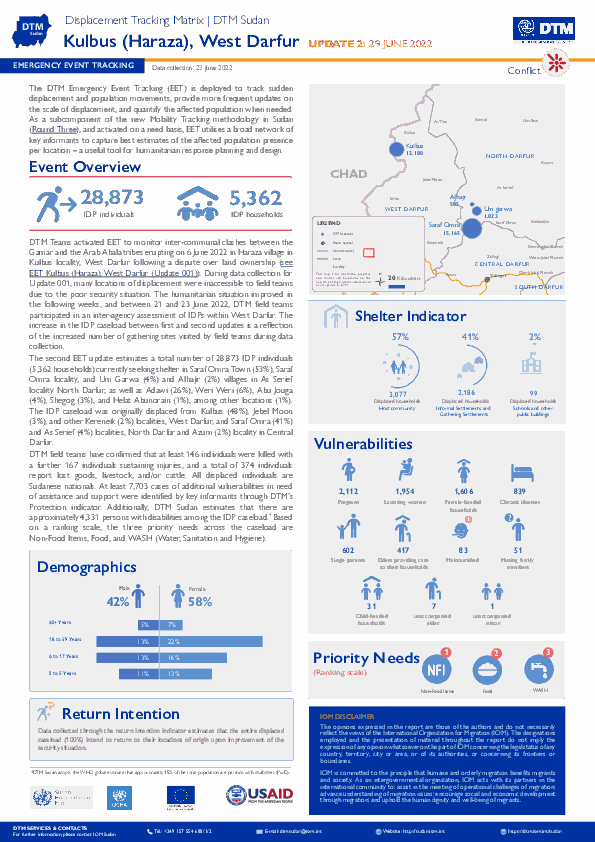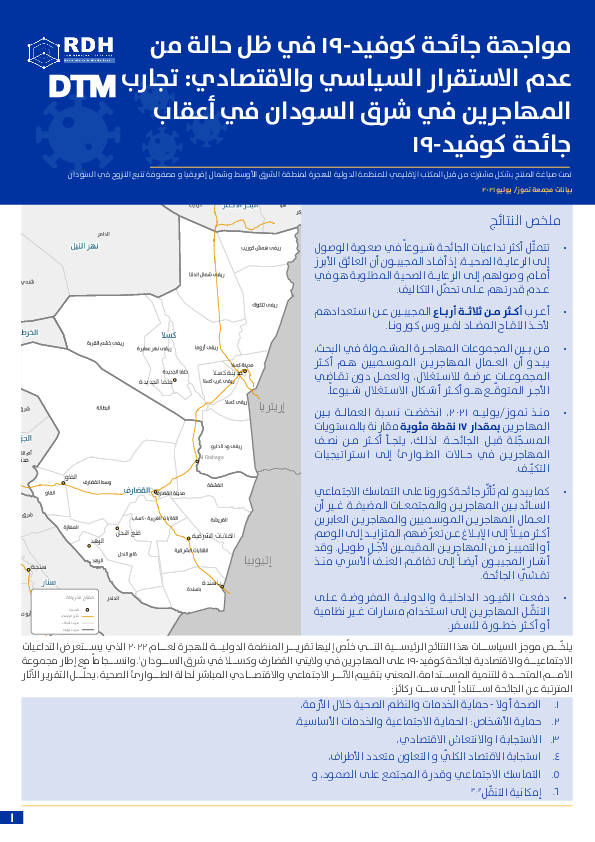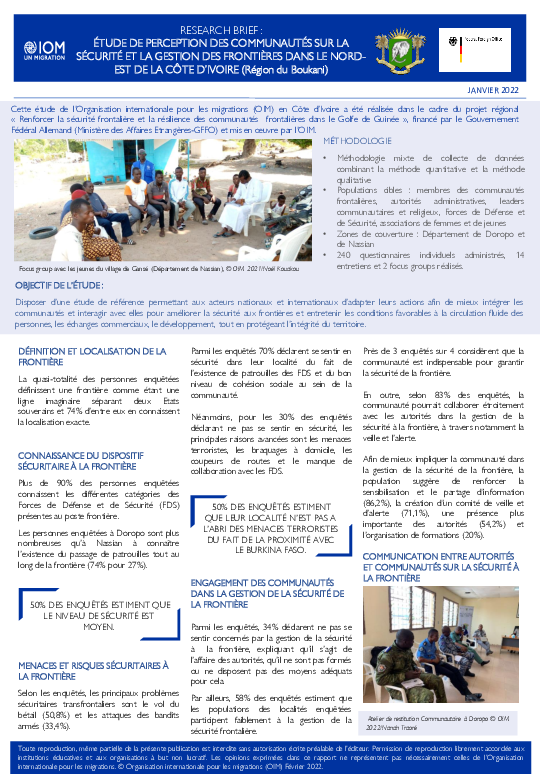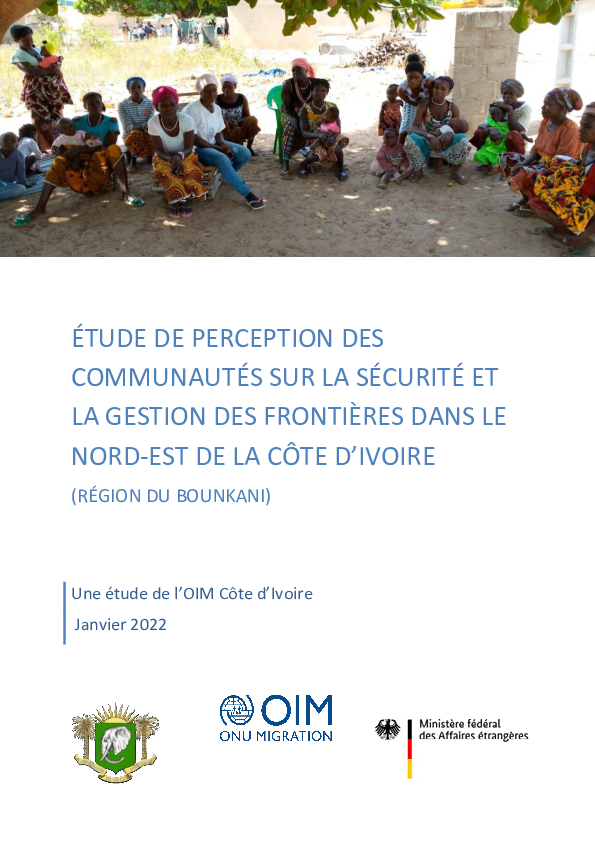-
Countries
-
Data and Analysis
-
Special Focus
-
Crisis Responses

Contact
DTM Europe, DTMMediterranean@iom.int
Language
English
Location
Slovakia
Period Covered
May 23 2022
Jun 24 2022
Activity
- Flow Monitoring
Since 24 February 2022, an increasing number of persons fleeing from Ukraine to the neighbouring countries has been observed, as a result of the war in Ukraine.
This report is based on cumulative and daily registrations by the Bureau of Border and Foreign Police of the Presidium of the Police Force (BBFP) of Ukrainian refugees and third-country nationals (TCNs) entering from Ukraine to the territory of Slovakia through all Border Crossing Points (BCPs), since 24 February 2022, numbers of those who exited the country towards Ukraine, as well as on number of those who applied for asylum or temporary protection in Slovakia.
To date, Ukrainian refugees represent 92 per cent (501,059) of all individuals registered at entry from Ukraine to Slovakia, with 6 per cent (30,845) of Third-Country Nationals (TCNs) and 2 per cent (9,822) of Slovak nationals recorded.
The Horn of Africa and Yemen is one of the busiest and riskiest migration corridors in the world travelled by hundreds of thousands of migrants, the majority of whom travel in an irregular manner, often relying on smugglers to facilitate movement along the Eastern Route. This regional report provides monthly updates on the complex migratory dynamics through Djibouti, Somalia, Yemen and Ethiopia based on diverse data sources and consultations with key informants in the four countries. Moreover, it provides information on the main protection concerns for migrants along the journey, information on the spill over effects of the conflict in Northern Ethiopia observed at the border between Ethiopia, Kenya and Sudan, a specific focus on children and information on the returns from Saudi Arabia to Ethiopia, Somalia and Yemen.

Contact
DTM Sudan; dtmsudan@iom.int
Language
English
Location
Sudan
Snapshot Date
Jun 23 2022
Activity
- Mobility Tracking
- Event Tracking
The DTM Emergency Event Tracking (EET) is deployed to track sudden displacement and population movements, provide more frequent updates on the scale of displacement, and quantify the affected population when needed. As a subcomponent of the new Mobility Tracking methodology in Sudan (Round Three), and activated on a need basis, EET utilises a broad network of key informants to capture best estimates of the affected population presence per location – a useful tool for humanitarian response planning and design.

Contact
DTM Sudan, DTMSudan@iom.int
Language
Arabic
Location
Sudan
Period Covered
Jun 01 2021
Jul 31 2022
Activity
- Other
- Community Perception
يلخـــص موجز السياســـات هذا النتائج الرئيســـية التـــي خلُص إليها تقريـــر المنظمة الدوليـــة للهجرة لعـــام 2022 الذي يســـتعرض التداعيات الإجتماعية و الأقتصادية لجائحة كوفيد-19 علي المهاجرين في ولايتيالقضارف و كسلا في شرق السودان. وانســـجاماً مع إطار مجموعة الأمم المتحدة للتنمية المستدامة، المعني بتقييم الأثر الإجتناعي و الإقتصادي المباشر لحالة الطوارئ الصحية، يحلّـــل التقرير الآثار المترتبة عن الجائحة اســـتناداً إلي ستة ركائز:
1- الصحة اولاً - حامية الخدمات والنظم الصحية خلال الأزمة،
2- حامية الأشخاص: الحامية الأجتماعية والخدمات الأساسية،
3- الأستجابة و الأنتعاش الأقتصادي،
4- استجابة الأقتصاد الكلّي و التعاون متعدد الأطراف،
5- التماسك الأجتماعي و قدرة المجتمع علي الصمود، و
6- إمكانيو التنقٌل.

Contact
DTM Nigeria, AllUsersInDTMNigeria@iom.int
Language
English
Location
Nigeria
Period Covered
Jun 20 2022
Jun 26 2022
Activity
- Mobility Tracking
- Event Tracking
Nigeria's north-central and north-west zones are afflicted with a multi-dimensional crisis rooted in long-standing tensions between ethnic and religious groups and involves attacks by criminal groups and banditry/hirabah (such as kidnapping and grand larceny along major highways). During the past years, the crisis has accelerated because of the intensification of attacks and has resulted in widespread displacement across the region.
Between the 20th and 26th of June 2022, armed attacks, rainstorms and communal clashes have led to new situations of forced displacement in the states of Benue, Kaduna, Sokoto and Zamfara. Following these events, a rapid assessment was conducted by DTM (Displacement Tracking Matrix) field staff to inform the humanitarian community and government partners, and enable targeted response. Flash reports utilise direct observation and a broad network of key informants to gather representative data and collect information on the number, profile and immediate needs of affected populations.
During the assessment period, the DTM identified an estimated 8,672 individuals who were affected by the attacks, 196 individuals by rainstorms and 120 individuals by communal clashes. A total of 8,593 individuals were displaced to neighbouring wards in Okpokwu LGA of Benue state, Kachia LGA of Kaduna state, Tureta LGA of Sokoto state, and Maradun and Gusau LGAs of Zamfara State as a result of the attack. Communal clashes in Langtang north LGA of Plateau State displaced about 119 individuals from their places of residence and 196 individuals were displaced by rainstorms in Kebbe LGA of Sokoto state to neighbouring shelters in the community. A total of 218 casualties were reported, including 138 injuries and 80 fatalities.
The lingering conflict in Nigeria's North East Zone has been the major cause of widespread population displacement. Over 2 million persons have been forced to leave their areas of residence in search of safety and security in neighbouring wards and LGAs.
On 20 June 2022, a Non-State Armed Group (NSAG) carried out an attack in Madagali ward in Madagali LGA of Adamawa State, leading to a wave of population displacement. Following the attack, a rapid assessment was conducted by DTM field staff with the purpose of informing the humanitarian community and government partners, and enabling targeted response. Flash reports utilise direct observation and a broad network of key informants to gather representative data and collect information on the number, profile and immediate needs of the affected population.
As a result of the attack, a total of 665 individuals from 133 households were displaced from their communities in Madagali ward to neighbouring localities within the same ward. The majority of those affected are refugees who are initially displaced from Cameroon. The displaced population is currently residing with residents in the host community and are in need of shelter, NFIs and food.

Contact
DTM Côte d'Ivoire, ANanquette@iom.int
Language
French
Location
Côte d’Ivoire
Period Covered
Dec 01 2021
Dec 31 2021
Activity
- Other
- Survey
- Community Perception
l’Organisation internationale pour les migrations (OIM), avec l’appui du Ministère fédéral allemand des affaires étrangères, a initié l’étude de perception des communautés frontalières de la Côte d’Ivoire avec le Burkina Faso sur la sécurité et la gestion des frontières. L’étude a consisté à analyser la perception des membres des communautés de Doropo et de Nassian dans la région frontalière de la Côte d’Ivoire avec le Burkina Faso sur le niveau de sécurité dans leur localité, y compris leur appréhension des menaces et tensions, leurs capacités de résilience face à l’insécurité, leur implication dans la sécurité (information, collaboration avec les forces de défense et de sécurité) et la coopération entre elles, les autorités ainsi que les forces de défense et de sécurité.
Le but de l'étude était de disposer d’une étude de référence permettant aux acteurs nationaux et internationaux d’adapter leurs actions afin de mieux intégrer les communautés et interagir avec elles pour améliorer la sécurité aux frontières et entretenir les conditions favorables à la circulation fluide des personnes, les échanges commerciaux, le développement, tout en protégeant l’intégrité du territoire.
L’enquête terrain a été conduite en décembre 2021 auprès d’un échantillon de 240 individus.

Contact
DTM Côte d'Ivoire, ANanquette@iom.int
Language
French
Location
Côte d’Ivoire
Period Covered
Dec 01 2021
Dec 31 2021
Activity
- Survey
- Community Perception
l’Organisation internationale pour les migrations (OIM), avec l’appui du Ministère fédéral allemand des affaires étrangères, a initié l’étude de perception des communautés frontalières de la Côte d’Ivoire avec le Burkina Faso sur la sécurité et la gestion des frontières. L’étude a consisté à analyser la perception des membres des communautés de Doropo et de Nassian dans la région frontalière de la Côte d’Ivoire avec le Burkina Faso sur le niveau de sécurité dans leur localité, y compris leur appréhension des menaces et tensions, leurs capacités de résilience face à l’insécurité, leur implication dans la sécurité (information, collaboration avec les forces de défense et de sécurité) et la coopération entre elles, les autorités ainsi que les forces de défense et de sécurité.
L’enquête terrain a été conduite en décembre 2021 auprès d’un échantillon de 240 individus

Contact
DTMUkraine@iom.int
Language
Ukrainian
Location
Ukraine
Period Covered
Jun 17 2022
Jun 23 2022
Activity
- Survey
Війна в Україні, яка розпочалася 24 лютого 2022 року, спричинила безпрецедентну гуманітарну кризу, що охопила всі області країни. У період з 17 по 23 червня Міжнародна організація з міграції (MOM) провела шостий раунд репрезентативного експрес оцінювання загального населення України для збору інформації стосовно потоків внутрішнього переміщення та мобільності, а також для оцінювання місцевих потреб. Це оцінювання загального
населення слугує первинним джерелом для виявлення сфер із високими гуманітарними потребами та визначення цільових заходів реагування для надання допомоги населенню, що постраждало від війни. Географічне охоплення цього оцінювання покриває всю територію України, усі п’ять макрорегіонів ( схід, північ, центр, південь та місто Київ), за винятком Кримського півострова.
Опитування загального населення було проведено шляхом набору випадкових телефонних номерів, завдяки чому було анонімно опитано 2 001 унікальних респондентів віком від 18 років із використанням методу автоматизованого телефонного опитування (CATI). Оцінка спирається на дані про населення Фонду народонаселення ООН (UNFPA), які гуманітарна спільнота розглядає як базове значення для чисельності населення в Україні. Особи, які нині перебувають за межами України, під опитування не потрапили. Докладніше про метод і обмеження, у тому числі про визначення МОМ терміну «внутрішньо переміщені особи» для цілей цього оцінювання, див на с. 11. Крім Опитування загального населення, офіційні дані про присутність ВПО на рівні громад в Україні доступні в Матриці відстеження переміщень Базовому оцінюванні (раунд 5 22 червня 2022 року, HDX реєстрація обов’язкова).
Цей звіт також доступний англійською мовою.

Contact
DTMcovid19@iom.int
Language
English
Location
Global
Period Covered
Jun 20 2022
Jun 27 2022
Activity
- Other
The DTM Global Mobility Restrictions Overview provides updates on international air travel restrictions and conditions for authorized entry. This overview aims to understand how COVID-19 has impacted human mobility, detailing how global and regional trends in air travel measures have evolved since COVID-19 was declared a global pandemic in March 2020. The data presented focuses on the changes in public health-related immigration and border management measures. It provides information intended to support IOM missions and partners in targeted response planning and advocacy for vulnerable populations who may be affected by changes in global mobility.


